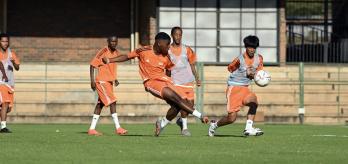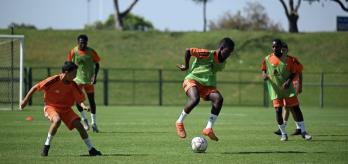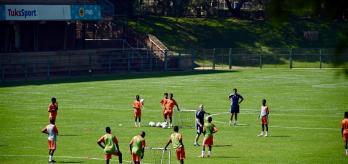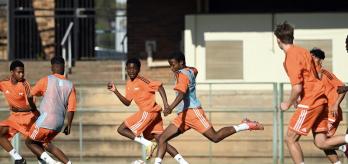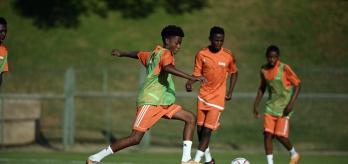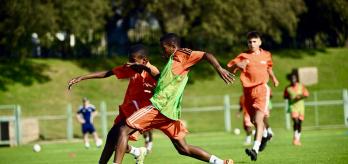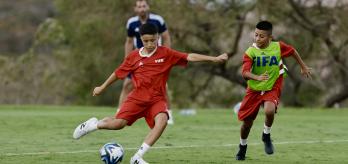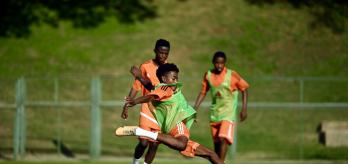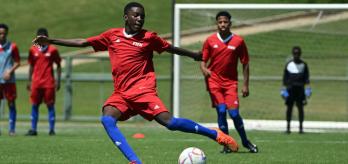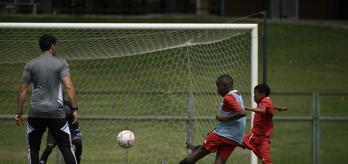Methodology
The intention: What is practised?
This attack v. defence exercise aims to enhance a unit’s ability to create and finish within a narrow focus. There are other aspects, such as securing possession, that do not feature in this particular exercise. The drill focuses on unit-level elements, such as quick final-third play and finishing against an unbalanced defence. In attacking transitions, the unit is tasked with reacting immediately, performing aggressive on- and off-the-ball actions and recognising when to dribble to entice defenders or pass to a better placed team-mate to take advantage of their numerical superiority. The unit must be prepared to transition defensively and should consciously keep players in defensive positions to avoid leaving themselves vulnerable to the opposition’s attack. When faced with a numerical disadvantage, the unit must focus on actions such as applying a moderate press, delaying opponents and shifting across to close off dangerous areas.
For whom is this relevant?
This exercise revolves around the unit, with a particular focus on quick finishing against an unbalanced defence. The drill is particularly relevant to attackers and defenders operating in transitional phases in which the defending team are at a numerical disadvantage and may have left spaces for the opposition to exploit. Given that the exercise requires a quick transition from defence into attack, and vice versa, the midfielders do not feature prominently. The focus is on the front three attackers, with potentially one or two players acting in a “rest defence” position to simulate a fast counter-attack. In a defensive transition, the exercise should simulate a recovering defence that drops deep and delays the opposition’s attack to allow team-mates to recover and achieve an equal numerical scenario.
How is the practice designed?
The exercise involves an attack v. defence scenario, featuring variable repetition that provides ample opportunities for the unit to practise being effective in transitions with numerical advantages and disadvantages. Variations develop to showcase different options that arise when faced with 2v1, 3v2 and 5v3 scenarios. The narrow exercise area centralises transitional play to reduce crossing possibilities and serves to create more finishing situations and infield off-the-ball runs. Furthermore, the reduced size of the exercise area, together with the nature of the exercise, which features numerical superiority, increases the regularity of attacks, allowing players to work on their decision-making skills. Two outside players enter the exercise area to ensure rapid transitions and force players to react quickly. The exercise is non-position-specific, with players able to roam freely and alternate between attack and defence, while players are tasked with deciding whether they should stay in defensive positions or support the attack.
Session plan
Organisation
-
Mark out a 40x25m exercise area.
-
Mark out a halfway line.
-
Position a full-size goal at each end of the exercise area.
-
Place a goalkeeper in each goal.
-
Split the group into 3 teams: 5 greens, 3 oranges and 2 blues.
-
Set up a 5v3 scenario between the greens and oranges inside the exercise area, with a blue outside player waiting on either side of the exercise area.
Explanation
-
The exercise starts with the greens in possession. Their aim is to exploit their 5v3 numerical advantage and score in the goal at the opposite end of the exercise area.
-
The oranges aim to defend their goal.
-
As soon as an attack is over (i.e. a goal is scored or following an attempt on goal), the 2 blue players enter the exercise area, and the second coach quickly plays a ball into an orange player.
-
The 2 blue players join the 3 orange players to create a 5v5 involving a 5v2 or 5v3 scenario and seek to take advantage of the imbalance in the greens’ defensive structure.
Key coaching points
Roles of coaches
-
First coach: leads the session and instructs the players during the transitions. Coaches the attacking team during a brief break.
-
Second coach: coaches the team with a numerical disadvantage.
- Third coach: serves balls into the oranges and offers encouragement and instructions to both sets of players.


























